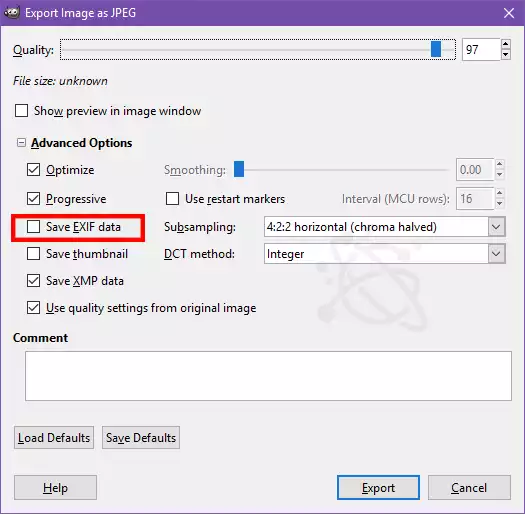You can also be interested in these:
- How to unpin someone on Snapchat – Two different methods
- The best programs to recover deleted files on the computer
- CPU over temperature error: Causes and fixes
- What is a sleeper PC and why should you build one
When taking a photo or recording a video, information is stored hidden in the image file. This information describes various characteristics of the place and time that content was created and may even include sensitive information like the address where the image capture occurred and who did it.
Is not recommended for other people to know this information, and less if they are not of your trust. For this reason, we created this guide so that you can eliminate the metadata of your photos and thus eliminating the EXIF file responsible to store this information. The data contents of this file can carry a long personal history behind each photo. Paying attention to the advantages and disadvantages of this file type can be the difference to discriminate when it is convenient to delete them or not.

What are EXIF files and what information do they whisper about you to others?
EXIF is the metadata stored as sensitive information within each image file. This information is captured at the time the photo is taken. Additional information may require an Internet connection or GPS to be able to determine info like the place where the photo was taken (although this is more a curse than a blessing). The EXIF information contains the following data, some more harmless than others, but equally damning if not taken care properly:
- The size of the photograph
- Resolution
- If the rotation effect has been applied
- A thumbnail image for preview
- Aperture and focal length
- Image compression type (its format)
- Shutter speed
- Information on the type of socket used
- With which application the photo was taken
- Whether or not the flash was activated
- Latitude and longitude where it was taken
- Capture date and time
- Author name
All the previous data elements seem low priority and for many don’t represent a danger to privacy. However, even the least information other people know about you can represent a danger, especially when the images reveal the location where they were took along with its time and date. If someone was looking to harm you, they would already know what time, what day and where to find you usually.
Is it important to delete the metadata and information of the images?
The vast majority of latest-generation smartphones or cameras have a GPS device that allows you to tag the images on a map, that is, to locate the images geographically so that you can know exactly where they were taken, in case you want to return to that place. This is not a problem if you were to keep the images for yourself, the problem is when you share these images with that sensitive data.
This gets worse if there are relevant patterns when taking the photos, for example, if every Sunday you go to the park around 3 in the afternoon, this information will be on a silver platter for people who may not have very good intentions, which usually happens when you share the images on a site where they can access. Therefore, it is necessary to remove the EXIF data.
Now, if you have already uploaded images to different social networks such as Facebook, Instagram or Whatsapp, you don’t have much to worry about, these networks apply a method of deleting additional information from the images and compression to reduce their weight. and do not overload the servers, in this way it is not necessary to delete the metadata, at least for these mentioned networks. The list of safe networks to share images without EXIF data are:
- Telegram (when sending the image with compression)
- Whatsapp (when sending the image from the gallery and not as a file)
Now, if you are a person who shares photos through specialized services such as Google Photos, Flickr, among others, it is possible that the elements you have uploaded still contain EXIF information, especially if you chose to upload them in the highest possible quality.
Now, what we are going to do is teach you how to remove this sensitive data from your photos, which is not a difficult process at all. We are going to show you how to carry out this process on different operating systems.
Remove EXIF data on Windows, Linux and MAC using GIMP
All operating systems have a default option that allows you to delete EXIF data, but in the event that the version of the one you are using does not allow it, you can carry out the process using GIMP, a free photo editing suite. To achieve this, do the following:
- Open the program.
- Drag the image whose additional information you want to delete to the program interface.
- Select File > Export
- Give it a different name than the original and select Export.
- A second window will appear where you have to uncheck “Save EXIF data”.
- When you press Save the image will have been saved with no available metadata.

How to remove metadata from a photo from Android?
In the case of Android, it will be necessary to use an application called Metadata Remove. With it you will be able to upload several photos and delete the metadata of them altogether. This app is available on the Google Play Store. With this app you can also take photos without metadata directly from the phone’s camera.
Remove EXIF data from iOS
Of course, if you have an Apple mobile you can also carry out this task, only with a different app, called Exif Metadata. Available in the Appstore, you will be able to add several images so that they are gradually erased EXIF data progressively (under a queuing system).
What is innovative about this app compared to the Android app is that you will also be able to edit these EXIF fields with the information you want.
Will you remove metadata from images?
Eliminating this type of sensitive information is absolutely necessary if you are concerned about your privacy and want to be totally sure no one will see your data. You can implement two folders in your operating system, one to store the images with their metadata intact and the other for the photos that you are going to upload to social networks, to which you will carry out the procedure to eliminate this information.
Of course, you can also remove the metadata only from the images you are going to upload, and thus avoid the laborious work of doing this with each of your photos.
More stories like this
- How to unpin someone on Snapchat – Two different methods
- The best programs to recover deleted files on the computer
- CPU over temperature error: Causes and fixes
- What is a sleeper PC and why should you build one
- What does an orange light on a motherboard mean
- 15 tricks and prompts to get the most out of ChatGPT
